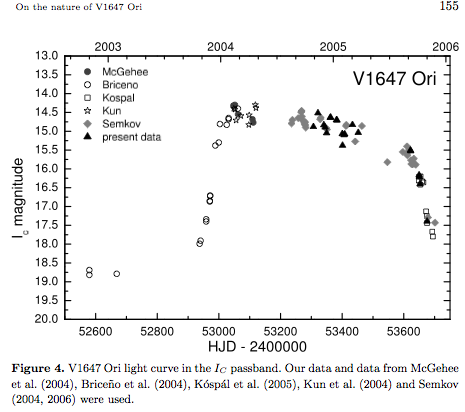Difference between revisions of "Triggers:FUOri"
From Gaia Science Alerts Working Group
Jump to navigationJump to search| Line 22: | Line 22: | ||
See Herbig (2007) [http://www.iop.org/EJ/article/1538-3881/133/6/2679/205809.text.html] | See Herbig (2007) [http://www.iop.org/EJ/article/1538-3881/133/6/2679/205809.text.html] | ||
| − | [[File:ExLupi. | + | [[File:ExLupi.png|right|300pix|thumb|EX Lupi photometry from Herbig(2007).]] |
* Recurent eruptions | * Recurent eruptions | ||
Revision as of 15:58, 28 October 2009
FU Orionis (FUors)
FU Orionis (V1647 Ori) is young pre-main sequence stars, illuminating a McNeil's nebula in the vicinity of NGC 2068 star-forming region.
 Plot from D.Chochol et al. 2006.
Plot from D.Chochol et al. 2006.
Characteristics:
- Very rare
- Outbursts repeat with a time scale of 40 years (1978, 2003)
- Amplitude: 5 mag over 4 months
- Outbursts last for 2 years
- Spectra: F or G supergiants
- Spectrum: red, heavily veiled continuum with strong emission of <math>H_{\alpha}</math>; in blue consistent with an early B spectral type
- X-ray variability present
- FU Ori and V1057 Cyg rise over 1 yr, whereas V1515 Cyg rise over 20 years
- FU Ori and V1515 Cyg decline over 20-100 years, V1015 Cyg decays faster (10 yrs)
Similar types to FU Ori
EX Lupis (EXors)
See Herbig (2007) [1]
- Recurent eruptions
- Amplitudes similar or smaller than in FUors
- Balmer emission lines, He I and other lines as in active T Tauri stars
OO Serpentis
OO Ser was discovered in 1994 and is similar to FUors and EXors, but is so deeply embedded, that at its brightest was not visible in J band (Hodapp et al. 1996). It was observed in infrared with Infrared Space Observatory and Spitzer (Kospal et al. 2007). It has different time scales than FUors and EXors, is rather a fast FUor (similar to V1647 Ori) with a time of rise of about 8 months.
